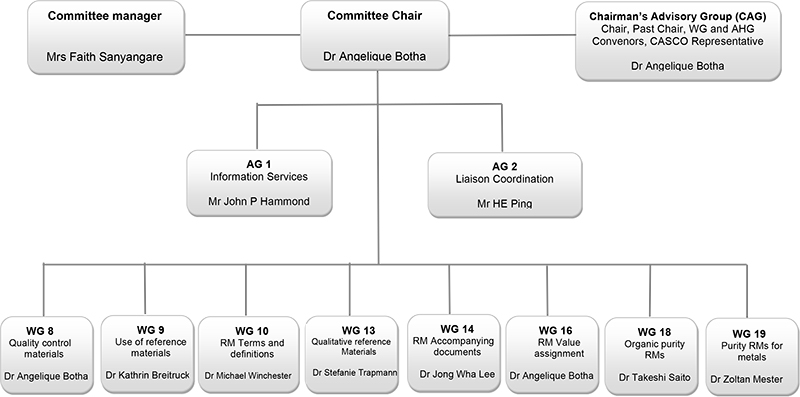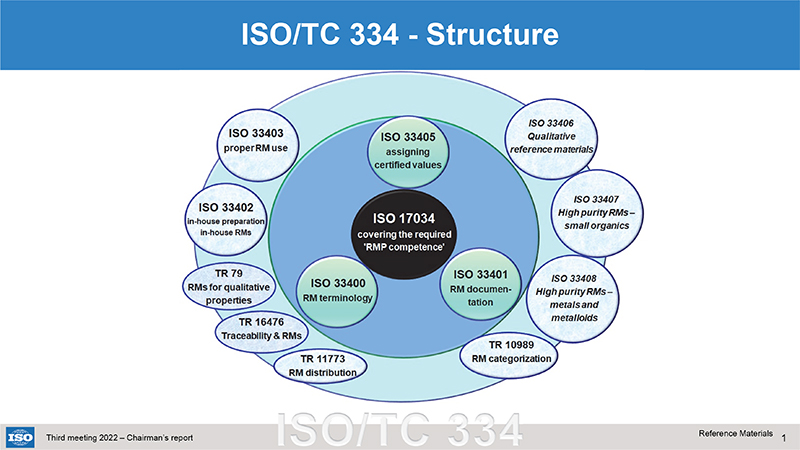John P. Hammond
Technical Manager, Starna Scientific Limited, 52–54 Fowler Road, Hainault, Essex IG6 3UT, UK
Introduction
There has always been and will continue to be collaboration between individual producers of reference materials (RMs), and in many countries around the World, you will find national “mirror” committees reflecting and inputting regional decisions into their appropriate ISO representatives. However, many years ago, RM producers recognised that the growing need by the analytical community for a number and variety of RMs as well as a need for the assurance of the quality of RMs called for collaboration at the international level. This has been achieved through REMCO, the Council Committee on Reference Materials of the International Organization for Standardization (ISO), which celebrated its 40th anniversary in 2016. The evolution of this organisation and its conversion into the formal ISO TC 334 – Reference Material continues in 2022 and beyond, and the key changes are detailed here, in a report of their latest annual meeting.
The essential role of supporting RM producers and Accreditation Bodies via the ISO 17034 standard1 route continues as one of the primary mandates of TC 334, but here is the first significant change in this TC.
By definition, an ISO Technical Committee’s main role is to write standards, appropriate to its defined area of expertise. Also, In the language of ISO, a “Guide”, is defined as an informative document which assists an ISO TC in the construction of standards, appropriate to the TC.
However, historically the ISO/REMCO Guides, in some cases, were not designed for this purpose, but were informative documents for RM producers per se. So, the first task that the new TC 334 has to consider is how to meet this requirement and convert these Guides into the appropriate standards, and this conversion essentially forms the basis for the work programme detailed below. To fulfil these conversions, either new or existing appropriate Working Groups were created and/or reinstated, as appropriate. The new committee structure that resulted is shown in Figure 1.

Figure 1. ISO/TC 334 Committee structure (2022).
In addition, in a TC structure a Working Group is tasked with a specific project plan, and associated timeframe to investigate (and produce if appropriate) a related standard. Within the old ISO/REMCO structure there were a couple of Working Groups (WG6 – Information Services and WG17 – Liaisons) that, whilst essential to the functioning of the TC, do not meet this requirement. Therefore, a structural rearrangement with respect to these essential requirements was made, converting these two groups to Advisory Group 1 (AG1) and Advisory Group 2 (AG2), respectively.
This article details the 3rd annual meeting of ISO TC 334. Held virtually as a video conference as three sessions on 7 June, 9 June and 14 June, it was well attended with 62, 55 and 52 participants, respectively, on each day.
Work programme
As stated above, the primary task of ISO TC 334 is the conversion of the existing ISO/REMCO series of Guides, into their equivalent ISO 334xx standards as shown in Table 1.
Table 1. ISO/REMCO Guides / ISO TC 334 Standards.
Working Group | Existing REMCO guide | New TC 334 standard |
WG 8: Quality control materials | ISO Guide 80 | ISO 33402 |
WG 9: Use of reference materials | ISO Guide 33 | ISO 33403 |
WG 10: RM Terms and definitions | ISO Guide 30 | ISO 33400 |
WG 13: Qualitative reference materials | ISO Guide 85 | ISO 33406 |
WG 14: RM Accompanying documents | ISO Guide 31 | ISO 33401 |
WG 16: RM Value assignment | ISO Guide 35 | ISO 33405 |
WG 18: Organic purity RMs | ISO Guide 86 | ISO 33407 |
WG 19: Purity RMs for metals | ISO Guide 87 | ISO 33408 |
As these new standards still essentially form the support structure to ISO 17034, this relational structure can be redrawn as shown in Figure 2.

Figure 2. Relationship structure of ISO/TC 334 standards to ISO 17034.
As you can see this is not an insignificant amount of work, given the required ISO publication dates in the period December 2023 to August 2024, and therefore, prior to this meeting, it had been discussed and agreed that for ISO 33401/2/3/5 the process would be to simply “fast-track” the transformation of these ISO/REMCO Guides (Guides 31/80/33/35) using a simple international balloting process in TC 334. However, for ISO 33400/6/7/8 (Guides 30/85/86/87), the complete standard development process will be followed, through the appropriate series of draft standards and/or ballots.
For these reasons the meeting essentially split into the following agenda:
- Report of the secretariat
This report, by the SABS, the ISO member for South Africa detailed the current structure of ISO TC334, which consists of experts in a range of diverse fields from over 40 countries. Anyone interested in getting involved should contact their national ISO member. It also detailed the existing extensive liaisons that ISO TC 334 had inherited from ISO/REMCO, both with similar ISO Technical Committees (TCs) and external international bodies.
- ISO TC 334 Strategic Business Plan
The Strategic Business Plan (SBP) was reviewed and approved. The extension of formal business planning to certain ISO committees is an important measure which forms part of a major review of business. The aim is to align the ISO work programme with expressed business environment needs and trends and to allow these committees to prioritise among different projects, to identify the benefits expected from the availability of International Standards, and to ensure adequate resources for projects throughout their development. It is expected that each committee member participates to the implementation of the Business Planning concept, thereby contributing significantly to the overall effectiveness of international standardisation. The SBP for TC 334 will be made available on the general public area of the ISO TC 334 website.
- Advisory group reports and proposed milestones
- AG1 : Information services
This group reported on its activities during the previous year, which centred principally on the development, and implementation of ISO TC 334’s own website area on the ISO website. This can be found at https://committee.iso.org/home/tc334.
- AG2 : Liaison coordination
As already stated, TC 334 has an extensive liaison network, both with ISO and external international committees, and the reports from these were summarised in this session. In addition, TC 334 member reports were also summarised detailing new RMs, areas of interest etc.
- Working Group reports and proposed milestones
- WG8: Quality control materials
- WG9: Use of RMs
- WG10: RM Terms and definitions
- WG13: Qualitative RMs
- WG14: RM Accompanying documents
- WG16: RM Value assignment
- WG18: Organic purity RMs
- WG19: Purity RMs for metals
These Working Group discussions reviewed the progress of the appropriate standard development, and highlighted progress, areas of concern etc. Work within these groups will continue throughout the upcoming year by the effective use of virtual meeting technology to arrange discussion and/or review meetings.
In conclusion, a very well run and effective meeting held “virtually” over the stated three days, and after a couple of years having to accommodate this process, we are all well versed in turning off cameras, and muting microphones to assist the smooth running of the video conferencing.
Interestingly, one upside appears to be the number of attendees, which was significantly more than any recent face-to-face meeting. However, this has to be balanced by the limited three-hour timeslot around midday to accommodate (as reasonably as possible) time zones from the USA/Canada in the West, to China/Japan in the East, and the informal discussions which invariably result. Therefore, moving forward, the most likely option for future meetings will be face-to-face with essential hybrid capabilities for those who either cannot, or wish not to, attend in person.
Maybe, similar discussions within ISO have resulted in the following recent statement to all TCs?
“…the President’s Committee has decided that decision-making around the modalities for governance and technical meetings be returned to the relevant group and committee leaders, with immediate effect.
This means that group and committee leaders will have the authority to decide whether a meeting should take place in virtual, hybrid or face-to-face format—without further approval required. To make such decisions, the committee leaders should continue to follow the ISO/IEC Meeting Guidance to ensure a productive and fair experience for all participants.”
References
- ISO 17034, General Requirements for the Competence of Reference Material Producers. International Organization for Standardization (ISO), Geneva, Switzerland (2016).

